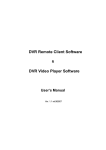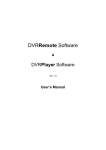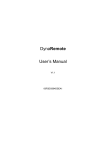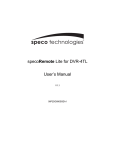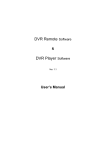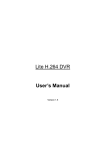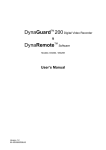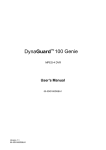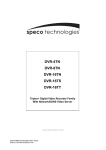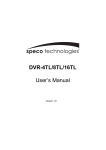Download AVE DRT16 User`s manual
Transcript
DVRRemote User’s Manual V1.3 00P279100ASEA3 Content 1. 2. 3. 3.1 3.2 4. 4.1 4.2 4.3 5. 5.1 5.2 5.3 5.4 Overview ...............................................................................................................4 System Requirements ...........................................................................................4 Getting Started with Setup Procedures..................................................................5 Changing Internet Settings .............................................................................5 Installing Remote Software.............................................................................6 3.2.1 Log in / Log off ........................................................................................8 3.2.2 Software Upgrades..................................................................................9 Basic Operation ...................................................................................................10 To View Live Video .......................................................................................10 4.1.1 Selecting Display Mode......................................................................... 11 4.1.2 Assigning Camera to Windows ............................................................. 11 4.1.3 Operating Cameras with Dome Control.................................................12 Instant Recording .........................................................................................13 4.2.1 Recording Video Instantly .....................................................................13 4.2.2 To Playback Instant Recording Video....................................................14 To Playback Video ........................................................................................14 4.3.1 To Playback Local *.drv Files ................................................................14 4.3.2 To Playback Instant Recording Video....................................................15 4.3.3 Playback Controls .................................................................................15 Configuring the Remote Unit ...............................................................................16 System Setup ...............................................................................................18 5.1.1 Version ..................................................................................................18 5.1.2 Language ..............................................................................................19 5.1.3 Date / Time............................................................................................20 5.1.4 Unit Name .............................................................................................22 5.1.5 Network Setup.......................................................................................23 5.1.6 RS485 Setup.........................................................................................24 5.1.7 Key Beep...............................................................................................25 Camera Setup ..............................................................................................26 Record Setup ...............................................................................................28 5.3.1 Schedule Setup.....................................................................................28 5.3.2 Preset Configuration..............................................................................30 5.3.3 ezRecord...............................................................................................32 5.3.4 Circular Recording ................................................................................33 Event Setup..................................................................................................33 5.4.1 Internal Buzzer ......................................................................................34 5.4.2 Event Icon .............................................................................................35 5.4.3 Alert Notification Setup .........................................................................36 2 5.4.4 Event Full Screen ..................................................................................37 5.4.5 Event Duration ......................................................................................38 5.4.6 Per Channel Configuration ....................................................................38 6. Trouble Shooting Guide.......................................................................................41 6.1 No Image Displayed after Connecting ..........................................................41 6.2 The System Asks for renewing .ocx .............................................................42 Appendix: Setting up a DVR behind a Router....................................................................44 3 1. Overview DVRRemote is a remote browser-based software application designed to operate with DRT16 / DRT8 DVR. By using the software, users are allowed to view live and recorded video. The DRT16 / DRT8 DVR automatically downloads the DVRRemote plug-ins to the connected PC when you connect to DRT16 / DRT8 DVR series unit by entering the IP address of the unit in the address field on the browser. The tasks that can be performed with DVRRemote are listed below: • Remote live viewing. • Remote control of dome cameras. • Up to three users can connect to one DRT16 / DRT8 DVR using DVRRemote at the same time. 2. System Requirements Items Minimum Requirements Personal Computer Pentium-3 600 MHz processor (Pentium Celeron or Pentium-4 1.5GHz processor preferred). RAM 256 MB minimum Hard Drive 20 MB available for software installation Operating System Window XP, 2003 Windows 2000 Microsoft Internet Explorer version 6.0 above, we abbreviate it as “IE” through the following pages. Web Browser NOTE: The use of DVRRemote requires ActiveX component; IE is recommended. Monitor The minimum monitor screen resolution requirement is 1024 x 768 with 16-bit color. Video Card XVGA with 16 MB video RAM Network Card 10Base-T (10 Mbps) or 100Base-TX (100 Mbps) operation; must match the network configuration 4 3. Getting Started with Setup Procedures Refer to the following descriptions to install the DVRRemote remote software. 3.1 Changing Internet Settings The browser that you want to operate with DVRRemote should be set to accept ActiveX plug-ins. Please follow the steps to set the Internet security settings appropriately. • Before you operate the remote software, please check the IP address of your DRT16 / DRT8 DVR series unit. To check the IP address, press MENU key on the remote DVR unit and enter password to access OSD Main menu; select <System Setup>, <Network Setup>, then <LAN Setup> to check the IP. • Start IE; and select <Tools> from the main menu of the browser, then <Internet Options>, and then click the <Security> tab. • Select <Trusted sites> and click <Sites> to specify its security setting. 5 • Disable Require server verification (https://******) for all sites in this zone. Type the IP address of the unit in field and click <Add> to add this web site to the zone. • Click <OK> to confirm the setting and close Trusted sites dialog. Now, you can continue with the rest of the DVRRemote setup. 3.2 Installing Remote Software Start IE to initiate the installation of DVRRemote on your personal computer. You can save the IP address of the remote unit as a Favorites item in your web browser to have easy access next time. • Start IE and enter the IP address of your DRT16 / DRT8 DVR series unit in the address field where is at the top of the browser. Shown as below figure. 6 • The ActiveX controls and plug-ins dialog will show twice for confirmation, click <YES> to accept ActiveX plug-ins. The DVRRemote plug-ins will be downloaded and installed on your PC automatically when the connection is successfully made. NOTE: Do not enter any leading 0 characters in the address, for example, “192.068.080.006” should be entered as “192.68.80.6”. NOTE: If the default trigger port 80 is changed into another one, take port 81 for example, you should enter the IP address as “192.68.80.6:81”. NOTE: You must have Windows Administrator privilege to update successfully. • A version check starts to verify whether DVRRemote has installed already, and also check if the version is the same as that stored on that particular DRT16 / DRT8 DVR series unit. This process may take up to 30 seconds. When the software is completely downloaded, the Login Screen is then displayed. 7 3.2.1 Log in / Log off DVRRemote allows up to four “Users” to access a DRT16 / DRT8 DVR series unit at the same time. The following steps demonstrate procedures to view video from remote unit: • Start DVRRemote by entering the IP Address of the remote DRT16 / DRT8 DVR series unit in the Address field of the browser. • Enter Username and password. The default Username and password is listed as below table. You can save password in the list if needed. • Username Password user 4321 Click <OK> to log in to the remote DRT16 / DRT8 DVR series unit. The process may take a few seconds. • If the connection is made successfully, the main window displays live video of the attached cameras. If the IE browser is closed, the user will be logged out of the system automatically 8 3.2.2 Software Upgrades When a new version of DVRRemote software is available on your DRT16 / DRT8 DVR series unit, it will be automatically installed when you access the unit. Follow the steps to upgrade the software. • The message “Browser will be closed” is now displayed. Click <Yes> to accept to version upgrade. • Start your IE again and enter the IP address of the remote DRT16 / DRT8 DVR series unit in the Address field of the browser. • When the software is completely downloaded, the Login Screen will be displayed. Please refer to Section 3.2.1 Log in/ Log off. 9 4. Basic Operation After the connection between your PC and the remote DVR unit is successfully made, the DVRRemote main window displays as below figure. The cameras connected to the remote unit will be listed on the left and an array of camera output windows displayed on the right of the main window. To view the main window in full-screen view, press <F11> on your keyboard. The features on DVRRemote main window will be described in the following sections. 4.1 To View Live Video You can view live video from the cameras attached to the remote DVR by clicking <Live> key on the main window toolbar. You can select desired display mode after the view on the DRT16 / DRT8 DVR series unit is displayed on the main window. To select wanted display mode, refer to the following sections. 10 4.1.1 Selecting Display Mode You can indicate the number of windows displayed on the main window. Click one of the display keys which is positioned on the left-bottom corner of the main window. You can select from 4, 9 and 16 camera displays. To view certain window in full screen, you may either double-click on the wanted window, or click on the corresponding CAMERA key. 4.1.2 Assigning Camera to Windows To assign a camera to a specific window in a multi-window display mode, follow the steps: • Select the desired display mode first by pressing the corresponding MODE button. • Click on the corresponding CAMERA key and drag the cursor onto the wanted display cameo. The assignment you make will not be saved when you exit DVRRemote. NOTE: The CAMERA button displays with a dome icon when the corresponding camera is equipped with dome control. 11 4.1.3 Operating Cameras with Dome Control DVRRemote allows you to control and configure a dome camera remotely. Click on any CAMERA key to view the camera in full screen display. Then click on a CAMERA key which is displayed with a dome icon. The Dome Control Panel (shown as right) will be displayed in the left side of the main window. The items on the dome control panel are described as follows. Set Preset Points This item is used to set up preset positions. DVRRemote allows setting up to 255 preset positions with DynaColor, American Dynamics, and Pelco (Pelco P & Pelco D) domes. Use Direction keys to move dome camera to an appropriate position, and then click the key and choose wanted number from the pull-down list. The preset position is named as the selected number. Go Preset Point This item is used to call the camera preset point which was set up with the set preset function. Click and choose a number to call the preset for viewing. A.F. (Auto Focus) Click to focus the camera automatically for a clear view. ID (Dome ID Setup) Click for changing the dome ID and protocol. User privileges in not allowed to change the dome ID and protocol; Admin privileges is needed to access this function. 12 Focus Use to adjust the camera lens to focus on objects for a clear view. Click the adjusting keys to modify the focus setting. Iris This item is used to open and close the iris to let more or less light into the camera. Click the adjusting keys to modify the iris setting. Zoom You are allowed to zoom-in or zoom-out using the adjusting keys. Zoom-in to view less area and zoom-out to view more area. Direction Keys These keys are used to pan and/or tilt the dome camera. Click the arrow key in the direction you want to view. 4.2 Instant Recording The Instant Recording function allows you to record video quickly on your PC. NOTE: The instant recording video will be saved as *.drv file. And the size of each *.drv file will be 700MB. If the recording is larger than 700MB, then it will be divided into 2 (or more) files. 4.2.1 Recording Video Instantly Follow the steps to start recording instantly: • Click on the <Instant Recording> key. • Select the destination you want to save the video. • Click on the button again to stop recording. NOTE: The instant recording video will be saved as *.drv file. NOTE: The Audio function is set to OFF as the default setting. 13 4.2.2 To Playback Instant Recording Video Follow the steps to playback a video recording instantly: • Click <Play> on main window toolbar and click <Local Playback> tab. • Click <Open> to choose a file recorded. • Click <OK> to start playing the recorded video. 4.3 To Playback Video To access the Playback screens, click <Play> key on the main window toolbar. The <Local Playback> tab enables you to play back a recorded video file with DVRRemote that was downloaded and stored on the hard disk drive of your PC. The remote DVR continues recording while you are playing back recorded video on your PC. 4.3.1 To Playback Local *.drv Files The <Local Playback> tab allows you to play back *.drv video files that stored on your PC's hard disk drive. The Local Playback screen is shown as below. Follow below steps to play back a downloaded *.drv file with DVRRemote. • Click <Open> and the file selection screen is displayed. • Select the *.drv video file to play back and click <OK>. • Click <OK> to start the operation, or click <Cancel> to abort the playback. 14 • View the video playback using the Playback controls. The Playback controls information refer to Section 4.3.3 Playback Controls. • After playback, click <Live> to return to live video. 4.3.2 To Playback Instant Recording Video Follow the steps to playback a video recording instantly: • Click <Play> on main window toolbar, the <Local Playback> tab displays. • Click <Open> to choose a *.drv file. • Click <OK> to start playing the recorded *.drv file. 4.3.3 Playback Controls When playing back local or remote video, DVRRemote is in Playback Mode. The playback controls toolbar is on the main window, as shown in the following figure. The Playback controls and indicators are described below. Fast Rewind Click to play the recorded video in reverse direction. Click repeatedly to select the rewind speed: 1×, 2×, 4×, 8×, 16×, or 32×. Play / Pause Click once to play the recorded video, click again to pause the playback. Fast Playback Click to play the recorded video forward. Click repeatedly to select the playback speed: 1×, 2×, 4×, 8×, 16×, or 32×. Stop Stop playing the recorded video. 15 5. Configuring the Remote Unit Click <MENU> key on the toolbar to configure a DRT16 / DRT8 DVR series unit remotely. The Configuration menu displays as below. Configuration Menu The Configuration menu contains a list of items that are used to configure DRT16 / DRT8 DVR series units remotely. The following subsections describe the configuration items and keys used in the OSD menu. NOTE: The settings in Configuration menu only apply to the unit. The Administrator can perform unit configuration freely. If you log in DVRRemote using User account, the most settings will be read only and cannot be configured. NOTE: If an Administrator account is currently accessing the unit OSD setup menu, you are not allowed to save the configuration as an Admin on DVRRemote. The DRT16 / DRT8 DVR unit administrator account has priority. 16 The items in Configuration menu are described in the table below. Item System Setup Camera Setup Record Setup Description Configures the system related items on the remote unit, such as password, date/time and network settings, etc. Configures camera titles and other camera-related items on the remote unit. Configures record-related items on the remote unit, such as event and audio recording parameters. Event Setup Configures the way in which the remote unit handles events. Database Setup Show the database information. It’s for read only. Keys in Configuration Screens The configuration screen contains several keys that enable you to save and close the settings. These keys are shown as below. The functions of these keys are described below. • <OK> You can save just the settings in the section of the Configuration screen in which you are working, click <OK> to save the settings and close the Configuration screen. • <Cancel> Click to close the screen without saving any changes. • <Apply> Click <Apply> to save all of the settings in the Configuration screen and apply them to the remote unit. 17 5.1 System Setup The System setup screen allows user to set language, date/time, and RS-485 settings on the remote unit. Click <MENU> key on the main window toolbar, and expand the System setup menu by clicking the plus icon. The expanded System Setup menu displays as the figure on the right. Items in the System Setup menu are described as following sections. 5.1.1 Version Show the Model Name, Hardware version and Software version of the connected unit, shown as the figure below. 18 5.1.2 Language The Language menu allows users to select the system language for OSD menu and screen messages of the remote unit. Language selection takes effect immediately when the selection is done. NOTE: The selection is used to change the system language of the remote DVR unit, but not for changing the language of the DVRRemote software. 19 5.1.3 Date / Time Click <Date/Time> to display the Date/Time menu, shown as follows. The menu allows user to configure the date/time related settings. NOTE: The following three items “Date/Time Display”, “Date/Time Display Mode” and “Date/Time Order settings” are applied to the remote DVR unit only. Date/Time Display User can set the date and time information to display in one or two rows. The default is <1 Row>. Date Display Mode Users are allowed to set the date-displayed mode for the remote unit. The date is comprised of Year (Y), Month (M), and Day (D). To change the date-displayed mode, click on the black arrow of this item and select the wanted option from the pull-down menu. The default display mode is <Y/M/D> in both NTSC and PAL formats. 20 Time Display Mode To set the time format of the remote DVR unit in 12 hour or 24 hour. The default setting is <24 HR>. Date/Time Order To set the order of Date/Time display to <Date First> or <Time First>. Daylight Saving Time The following items are used for those people who live in certain regions to observe Daylight Saving Time. Select <ON> to enable the following DST settings, or <OFF> to disable the function. • DST Start/ DST End The items are used to set the daylight saving duration. Enter the wanted DST start time and end time into both fields using the keyboard directly, or use the pull-down menu to select the desired date and time. • DST Bias The item is used to set the amount of time to move forward from the standard time for Daylight Saving Time. The Available options are <30>, <60>, <90> and <120> minutes. When you have completed the settings, remember to take one of the following actions. • Click <OK> to save the modified settings. • Click <Apply > to save all modified settings set in the configuration menu. • Click <Cancel> to abort and leave all settings unchanged. 21 5.1.4 Unit Name The item is used to change the unit name of the connected remote DVR unit. To change the unit name, type the new name in the field directly using the keyboard. 22 5.1.5 Network Setup This item allows the user to setup the DDNS automatically or manually. Dynamic Domain Name System (DDNS) allows a DNS name to be constantly synchronized with a dynamic IP address. In other words, it allows those using a dynamic IP address to be associated to a static domain name so others can connect to it by name. Once the setting is completed, the DDNS address will be: http://yourhostname.ddns.iview-ddns.com For example, if the chosen Host name is “*******”, then the address will be: http://*******.ddns.iview-ddns.com - Enable DDNS The item is used to enable or disable the Dynamic Domain Name Service. Select <YES> to enable the service, or <NO> to disable. - Host Name The item allows user to setup a domain name. - DDNS Port The item allows user to setup the port for DDNS. - Submit/Update When the user has completed the settings, choose <Yes> to submit the changes 23 - ezDDNS ezDDNS enables the users to register the host name automatically. NOTE: The DVR must be connected to the *Real IP address, or be assigned a specific port using **Port Forwarding technique. *A "Real IP" is one that is assigned to you by your ISP. **A "Virtual IP" is one assigned either manually or through DHCP. When the user is assigned a Virtual IP, the user must use Port Forwarding technique to assign a specific port to the DVR. 5.1.6 RS485 Setup Used to set up the parameters of the remote unit’s RS-485 communications port. Click <RS485 Setup> to display the RS485 Setup menu. • Unit ID Used to change the RS-485 ID address of the unit. The ID starts from <1> to <255>. The default is <224>. NOTE: NO two units on the same bus should have the same RS485 ID. 24 5.1.7 • Baud Rate Allow user to specify the baud rate for RS485 port. The available options are <2400>, <4800>, <9600>, <19200> and <38400>. The default is <9600> baud. • Bits Users are able to specify the bits that are associated with the protocol. The available options are <6>, <7> and <8> bits. The default is <8> bits. • Stop Users are able to specify the stop bit associated with this protocol. Options are <1> and <2> stop bits. The default is <1> stop bit. • Parity Used to specify the parity associated with this protocol. Options are <ODD>, <EVEN>, and <NONE>. The default is <NONE>. Key Beep The item is used to enable or disable the unit’s key tone. Select <YES> to enable the key tone, or <NO> to disable. 25 5.2 Camera Setup Camera Setup menu allows users to configure camera-related items of the DVR unit remotely. Click <MENU> key on the main window toolbar, and then click <Camera Setup> to expand the menu. Click on the desired channel to set its corresponding parameters. Items listed in the menu are described as follows. Dome Protocol Used to select the communications protocol associated with the connected dome camera(s). The available protocol includes <DynaColor>, <AD422>, <Pelco D>, <Pelco P>, <Fastrax 2>, <JVC>, and <None> (default). Dome ID Used to assign an ID number to the selected dome camera. Note that ID number you set here must match with the ID set on the dome. 26 Camera Title Allow users to set a title of camera connected to the unit (up to 11 characters). The title will be displayed both on the remote DVR unit's main monitor and the DVRRemote main window. Enter a camera title to the entry field using a keyboard directly. By default, the titles of cameras are numbered from 1 through 16 respectively. Covert Users are able to choose certain camera to be covert while the unit is continuing recording video. Choose a desired channel first and set the item <Covert> to <YES>. <YES> means to covert the selected camera, and <NO> means not to covert the selected camera. The default setting is <NO>. Termination Used to enable / disable the 75Ω termination resistor inside the unit to adjust the image quality of each camera channel. <YES>= termination resistor enabled (default); <NO> = termination resistor disabled. NOTE: If there is no any connection is made on camera loop-out connectors, the termination resistor should be enabled for appropriate signal termination. Brightness Used to adjust the image’s brightness of the selected camera displayed on the monitor. Contrast Used to adjust the image’s contrast displayed on the monitor of the selected camera. Saturation Used to adjust the image’s saturation displayed on the monitor of the selected camera. Hue Used to adjust the image’s hue displayed on the monitor of the selected camera. 27 5.3 Record Setup Record Setup menu allows users to set record-related items, such as recording schedule, pre-set configuration, pre-alarm recording time, or circular / linear recording, etc. Click <MENU> key on the main window toolbar, and click the plus icon to expand Record Setup menu. 5.3.1 Schedule Setup Schedule Setup menu is used to set the daytime, nighttime, and weekend recording schedule. The Night and Day schedules are used to define daytime and nighttime; the Weekend schedule is tailored for weekends and holidays. • Day/ Night Time Start Day Time Start/ Night Time Start determine the beginning of daytime and nighttime, respectively. The option is indicated in 1-minute increments. The time display format is based on the setting on Time Display Mode. 28 • Day/ Night Time End Day Time Start/ Night Time End determine the end time of daytime and nighttime, respectively. The option is indicated in 1-minute increments. The time display format is based on the setting on Time Display Mode. • Weekend Schedule The Weekend Schedule determines whether a weekend schedule is in effect. Choose <YES> to take effect the related weekend settings. • Weekend Start/End Weekend Start Time indicates the specific day and time that a weekend begins, for example, FRI 18:00. The Weekend End Time indicates the specific time and day that a weekend ends, for example, MON 06:00. Time is indicated in 1-minute increments. Note that the value you have set indicates when the regular Day and Night scheduling ends, and Weekend recording begins. 29 5.3.2 Preset Configuration <Preset Config> is used to select the preset recording quality and frame rate. Different default recording quality levels are offered for users to choose from: <Best Quality>, <Standard>, <Extended Record>, <Event Only>, <ezRecord>, <512Kbps DSL>, <256Kbps DSL>, and <128Kbps DSL> According to various Record modes, the preset configuration options for normal and event status are described in terms of relative recording rate (PPS) and recording size for each channel in the below tables. 30 The preset conditions override any other quality and rate settings. The default Preset Configuration setting is <Standard>. Record Mode: Full-D1 mode (NTSC: 720×480@30PPS) (PAL: 720×576@25PPS) Preset Normal Event Normal PPS Event PPS Event Active Configuration Quality Quality Both 15 NTSC 3.75 NTSC 20 KB 20 KB Best Quality (Alarm+Motion) (12.5 PAL) (3.125 PAL) 15 NTSC 3.75 NTSC 20 KB Both 14 KB Standard (12.5 PAL) (3.125 PAL) Extended 3.75 NTSC 15 NTSC 8 KB 20 KB Both (3.125 PAL) (12.5 PAL) Record 30 NTSC 0 NTSC 20 KB Both Event Only (25 PAL) (0 PAL) ezRecord Auto Auto Auto Auto Auto NOTE: If selecting this Record mode, only the image from channel 1~4 will be recorded. Record Mode: Half-D1 mode (NTSC: 720×240@60PPS) (PAL: 720×288@50PPS) Preset Normal Event Normal PPS Event PPS Event Active Configuration Quality Quality 3.75 NTSC 30 NTSC Both Best Quality 17 KB 17 KB (3.125 PAL) (25 PAL) (Alarm+Motion) Standard 3.75 NTSC (3.125 PAL) 11 KB 30 NTSC (25 PAL) 17 KB Both Extended Record 3.75 NTSC (3.125 PAL) 5 KB 30 NTSC (25 PAL) 17 KB Both 0 NTSC (0 PAL) - 30 NTSC (25 PAL) 17 KB Both Auto Auto Auto Auto Auto Event Only ezRecord Record Mode: CIF mode (NTSC: 360×240@120PPS) (PAL: 360×288@100PPS) Preset Normal Event Event Active Normal PPS Event PPS Configuration Quality Quality 7.5 NTSC 30 NTSC Both Best Quality 14 KB 14 KB (6.25 PAL) (25 PAL) (Alarm+Motion) Standard 7.5 NTSC (6.25 PAL) 8 KB 30 NTSC (25 PAL) 14 KB Both Extended Record 7.5 NTSC (6.25 PAL) 2 KB 30 NTSC (25 PAL) 14 KB Both 0 NTSC (0 PAL) - 30 NTSC (25 PAL) 14 KB Both Auto Auto Auto Auto Auto Event Only ezRecord 31 5.3.3 ezRecord This item aims to avoid the complicated record settings, and to make the setup much easier. To setup the ezRecord Setup, follow these steps: • <How Many Days To Record>: The average normal PPS & Quality will be adjusted automatically. The maximum of days depends of the size of your HDD, in other words, the larger the HDD installed, the more days the unit can record. • <Daytime Record>: This item is for you to select whether you want the DVR to record during daytime. • Repeat the same procedures for the Night and Weekend, respectively. Note that <Weekend Record> will be not accessible if you select <NO> for the item <Weekend Schedule> in <Schedule Setup>. • <Average Normal PPS>: Select the PPS, and the <How Many Days To Record> will be computed automatically. • <Average Normal Quality>: Select the Quality, and the <How Many Days To Record> will be computed automatically. NOTE: The current number of connected cameras will affect the recording quality automatically calculated through the <ezRecord Setup>. Therefore, once you disconnect cameras or connect more cameras to the unit, you should reset the <ezRecord Setup>. 32 5.3.4 Circular Recording Users are able to record video either in circular mode or in linear mode. If you choose to record in circular mode, then the unit begins to overwrite the oldest previously recorded video; and stores new video over the HDD spaces. If you choose to record in linear mode in stead, the unit stops recording when the HDD is full. Select <ON> to record video in circular mode, or <OFF> in linear mode. 5.4 Event Setup Event Setup menu allows users to determine DRT16 / DRT8 DVR series unit’s behavior in response to an alarm event. Click <MENU> key on the main window toolbar, and click the plus icon to expand the Event Setup menu. 33 5.4.1 Internal Buzzer This item allows user to enable / disable the unit’s internal buzzer. If set to <ON>, the buzzer is activated in response to an alarm. If set to <OFF>, the buzzer is not activated. The default setting is <ON>. 34 5.4.2 Event Icon Users are able to enable (ON) / disable (OFF) the display of Event Icon on the monitor when an alarm event occurs. The default setting is <ON>. 35 5.4.3 Alert Notification Setup This function allows the user to send alert notifications through the CMS program. For detailed setup instruction, please refer to the CMS user’s manual. • Alert Configuration Set 1, 2, and 3 Alert Configuration Set provides 3 combinations of Alert Notification, IP, and Port. • Alert Notification 4 options are included in this item; OFF, Event, Alive, and Both. <OFF>: The Alert Notification is OFF. <Event>: When the alarm is triggered, the DVR will send an alert message to the CMS. <Alive>: The DVR will send an alert message to the CMS every 2 minutes which also indicates that the connections between the DVR and CMS is in effect. <Both>: This enables the DVR to send both Event and Alive alert package to the CMS. • Alert IP The Alert IP must match the IP address of the CMS. • Alert Port The Alert Port must match the port of the CMS. 36 5.4.4 Event Full Screen This function sets the DVR to display Full Screen in Main, Call, or Both monitors when an event takes place. 37 5.4.5 Event Duration Determine the duration of the buzzer and Alarm Out relay function after an alarm is triggered. The available event duration range is from 1 second to 100 seconds. The default is 5 seconds. 5.4.6 Per Channel Configuration This item is used to set how alarm conditions are handled. Select a desired channel and configure its settings, such as Video Loss Detect, Motion Detect and Alarm In / Out functions. Video Loss Detect Used to enable / disable Video Loss as an alarm event. Select <ON> to enable Video Loss alarm events, <OFF> to disable. 38 Motion Detect Used to enable or disable the motion detection function of the DRT16 / DRT8 DVR series. By default, the value is <OFF>. If motion detection function is enabled, it is required to define the motion detection parameters such as detection area and sensitivity settings. Detection Configuration Click and the menu displays as below figure. • Sensitivity The item is used to set the sensitivity of detection grids for the camera. A greater value indicates more sensitive motion detection. A motion alarm will be triggered, once the amount of motion detected exceeds the Threshold value. Click UP / DOWN arrow keys to adjust the value. The value is indicated in 4% increment. Note that every time you have changed the value, remember to click on “Apply” key to make the change take effect. 39 • Area Threshold <Area Threshold> indicates the motion alarm triggered level; if the percentage of triggered grids to total detection area is greater than the set value, the motion alarm will be triggered. For example, if 10 grids are selected and the <Area Threshold> value is 70%, the motion alarm will be triggered when seven grids are motion detected. Click UP / DOWN arrow keys to adjust the value. The value is indicated in 4% increment. Note that every time you have changed the value, remember to click on “Apply” key to make the change take effect. After the change(s) have been made (remember to click on “Apply”), click to start detecting; click to select all grids; and click to stop detecting; click to clear all selected grids. Alarm In This item allows user to enable / disable alarm input detection. According to your application, select <N/O> (Normal Open) or <N/C> (Normal Close) to enable the alarm input detection or select <OFF> to disable the detection. The default setting is <OFF>. If you set this item to <N/C> but did not install any device to the unit, the alarm will be triggered and the Event Icon displayed continually until this item is changed to <N/O>, <OFF> or install a device to the unit. Alarm Out This item allows user to assign an alarm on certain channel to activate the relays. These signals can be used to drive a light or siren to caution an alarm event. Select from the options: <A Only> indicates “Alarm Out A”, <B Only> indicates “Alarm Out B”, <Both> indicates “Both Alarm Out” and <None> indicates “No Alarm Out”. The default setting is <None>. 40 6. Trouble Shooting Guide 6.1 No Image Displayed after Connecting If you have done all the internet settings mentioned in the Section 3.1 Changing Internet Settings, and still no image displayed after the connection between the remote DVR and your PC is made, then please follow these steps to change your security settings: • Start IE, and then select <Tools> form the main menu of the browser, then <Internet Options>, and then click the <Security> tab. The Security Settings screen is displayed as below. 41 • Click <Custom Level>, and below figure displays. • Under <All ActiveX controls and plug-ins>, set all items to <Enable> or <Prompt>. • Click <OK> to accept the settings and close the <Security> screen. Click <OK> to close Internet Options dialog. 6.2 The System Asks for renewing .ocx What if the server ask for .ocx renewal all the time when you trying to connect to the remote software? If the following screen displays repeatedly, please follow the steps to delete the temporary internet files. 42 • Select <Tools> from the main menu of the web browser, then <Internet Options>, and then click the <General> tab. • Click the <Delete Files> key in the Temporary Internet Files field; the screen displays as below. • Enable the <Delete all offline content> and click <OK>. • Now, enter the IP address of your DRT16 / DRT8 DVR series unit to make the connection again. 43 Appendix: Setting up a DVR behind a Router This appendix describes how to set up a router if the DVR connects to the internet via a router. To properly operate a web server, e.g. a DVR, the user has to set up both the IP and port of the DVR, which are essential for data and command transmission. The port setting is adjustable in OSD setup menu of DVR and only one port is needed to do remote operation. Typically and by the default, the DVR operates on port 80, which is well known as the http port. Please make sure that port 80 is not blocked by your ISP or you will have to find another available port and change the setting of the DVR. In case a router, or sometimes a DSL modem is in place, the real IP is now assigned to the router instead of the DVR. The DVR is located behind the wall (router) and operates on virtual IP. In most cases, virtual IP starts with 192.168.x.x. The router has two IPs- one is real IP (WAN IP), the other is virtual IP (LAN IP). The virtual IP would be 192.168.x.1. When the remote user wants to operate the DVR, he will have to send command to the real IP, i.e. the router, the router has to map (forward the command to the DVR. Thus it is required to set up the router for port mapping (forwarding) before you can see image remotely from your DVR. See your router manufacturer's websites for more instructions on port mapping. 44 Following is an example of how the router should be set. PC Router (D-Link DI-724P+) DVR 1 IP: 192.168.0.100 WAN IP: 218.160.54.13 DVR 2 IP: 192.168.0.167 IP: 192.168.0.200 Trigger port: 80 Trigger port: 81 LAN IP: 192.168.0.1 • To change the setting of the router, you need a PC with web browser. • Connect to D-Link DI-724P+ from PC via IE. The setup screen will show after entering the correct user name and password. • Click the <Advanced> tab and follow the steps to set up web port forward to DVR 1. A. Select the <Enabled> to set up the service. B. Enter the name of the setting in the Name field: DVR 1. C. Enter Private IP: 167 D. Choose <TCP> as the Protocol Type. E. Enter Private Port: 80. F. Enter Public Port: 80. G. Click <Always> for the Schedule setting. H. Click <Apply>. 45 • Click <Continue> to go on when the following screen displays. • Follow the steps to set up web port forward to DVR 2. A. Click <Enabled> to set up the service. B. Enter the name of the setting in the Name field: DVR 2. C. Enter Private IP: 200 D. Choose <TCP> as the Protocol Type. E. Enter Private Port: 81. F. Enter Public Port: 81. G. Click <Always> for the Schedule setting. H. Click <Apply>. • Now you can see DVR 1 via http://218.160.54.13:80 and DVR 2 via http://218.160.54.13:81. • If there are more than one DVR behind the router, repeat the steps for port mapping setting. 46















































